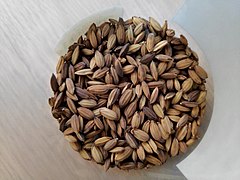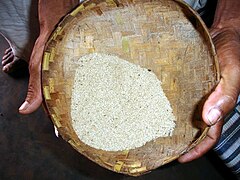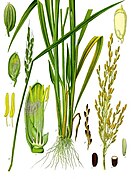Oryza sativa
| Oryza sativa | |
|---|---|

| |
| Mature seed heads | |

| |
| Inflorescence | |
| Scientific classification | |
| Kingdom: | Plantae |
| Clade: | Tracheophytes |
| Clade: | Angiosperms |
| Clade: | Monocots |
| Clade: | Commelinids |
| Order: | Poales |
| Family: | Poaceae |
| Genus: | Oryza |
| Species: | O. sativa
|
| Binomial name | |
| Oryza sativa | |
| Synonyms[1] | |
|
List
| |
Oryza sativa, commonly known as Asian rice, is the plant species most commonly referred to in English as rice. It is the type of farmed rice whose cultivars are most common globally, and was first domesticated in the Yangtze River basin in China 13,500 to 8,200 years ago.[2][3][4][5]
Oryza sativa is a grass with a genome consisting of 430Mb across 12 chromosomes. It is renowned for being easy to genetically modify and is a model organism for cereal biology.
Classification[]
Oryza sativa contains two major subspecies: the sticky, short-grained japonica or sinica variety, and the nonsticky, long-grained indica rice variety. Japonica was domesticated in the Yangtze Valley 9-6,000 years ago,[6] and its varieties are usually cultivated in dry fields (it is cultivated mainly submerged in Japan), in temperate East Asia, upland areas of Southeast Asia, and high elevations in South Asia, while indica was domesticated around the Ganges 8,500-4,500 years ago,[6] and its varieties are mainly lowland rices, grown mostly submerged, throughout tropical Asia. Rice occurs in a variety of colors, including white, brown, black, purple, and red rices.[7][8] Black rice (also known as purple rice) is a range of rice types, some of which are glutinous rice. Varieties include Indonesian black rice and Thai jasmine black rice.[citation needed]
A third subspecies, which is broad-grained and thrives under tropical conditions, was identified based on morphology and initially called javanica, but is now known as tropical japonica. Examples of this variety include the medium-grain 'Tinawon' and 'Unoy' cultivars, which are grown in the high-elevation rice terraces of the Cordillera Mountains of northern Luzon, Philippines.[9]
Glaszmann (1987) used isozymes to sort O. sativa into six groups: japonica, aromatic, indica, aus, rayada, and ashina.[10]
Garris et al. (2004) used simple sequence repeats to sort O. sativa into five groups: temperate japonica, tropical japonica and aromatic comprise the japonica varieties, while indica and aus comprise the indica varieties.[11]
Nomenclature and taxonomy[]
Rice has been cultivated since ancient times and oryza is a classical Latin word for rice. Sativa means "cultivated".[12]
Genetics[]
SPL14/LOC4345998 is a gene that regulates the overall architecture/growth habit of the plant. Some of its epialleles increase rice yield.[13] An accurate and usable Simple Sequence Repeat marker set was developed and used to generate a high-density map in McCouch et al 2002. A multiplex high-throughput marker assisted selection system has been developed by Masouleh et al 2009 but as with other crop HTMAS systems has proven difficult to customize, costly (both directly and for the equipment), and inflexible.[14] Other molecular breeding tools have produced results, producing blast resistant cultivars.[15][16][14] Xu et al 2014 used a DNA microarray substantially advance understanding of hybrid vigor in rice, by Takagi et al 2013 using QTL sequencing, and various agronomic traits by Yano et al 2016 using GWAS by WGS. (Because the correspondence between genotype and phenotype is more easily understood in rice, translation of results from rice to other non-models may require more work. For example grain size and grain weight in wheat was elucidated in this way by Valluru et al 2014.) Affymetrix offers a 44 thousand pot microarray, a 50 thousand, and a one million, and Illumina has a six thousand and a 50 thousand, all of which have performed well and are commonly used. Rice is one of the earliest uses and validation models for the (STARP) developed in Long et al 2016.[14]
In total 641 copy number variations are known, the combination of results of Ma and Bennetzen 2004 and Yu et al 2011. Exome capture often reveals new single nucleotide polymorphisms in rice, due to its large genome and high degree of DNA repetition. There have been two major results of this type, Saintenac et al 2011 and Henry et al 2014.[14]
Breeding[]
A triple introgression of resistance genes against Magnaporthe grisea - and actual field resistance - have been demonstrated by Khan et al 2018. This is a marker-assisted backcross of , , and into an aromatic cultivar using SSR- and STS-markers.[17]
Gallery[]

Water buffalo being used to plough rice fields in Java

Jumli Marshi, brown rice from Nepal

Traditional rice of Niyamgiri Hills, India

Rice from Chhattisgarh

O. sativa

Rice stem cross section magnified 400 times
See also[]
- Black rice
- Domesticated plants and animals of Austronesia
- International Code of Nomenclature for Cultivated Plants
- Japonica rice
- Maratelli rice
- Oryza glaberrima (African rice)
- Traceability of genetically modified organisms
References[]
- ^ "Oryza sativa L." Plants of the World Online. Board of Trustees of the Royal Botanic Gardens, Kew. 2017. Retrieved December 21, 2020.
- ^ Normile, Dennis (1997). "Yangtze seen as earliest rice site". Science. 275 (5298): 309–310. doi:10.1126/science.275.5298.309. S2CID 140691699.
- ^ Vaughan, DA; Lu, B; Tomooka, N (2008). "The evolving story of rice evolution". Plant Science. 174 (4): 394–408. doi:10.1016/j.plantsci.2008.01.016.
- ^ Harris, David R. (1996). The Origins and Spread of Agriculture and Pastoralism in Eurasia. Psychology Press. p. 565. ISBN 978-1-85728-538-3.
- ^ Zhang, Jianping; Lu, Houyuan; Gu, Wanfa; Wu, Naiqin; Zhou, Kunshu; Hu, Yayi; Xin, Yingjun; Wang, Can; Kashkush, Khalil (December 17, 2012). "Early Mixed Farming of Millet and Rice 7800 Years Ago in the Middle Yellow River Region, China". PLOS ONE. 7 (12): e52146. Bibcode:2012PLoSO...752146Z. doi:10.1371/journal.pone.0052146. PMC 3524165. PMID 23284907.
- ^ a b Purugganan, Michael D.; Fuller, Dorian Q. (2009). "The nature of selection during plant domestication". Nature. Nature Research. 457 (7231): 843–848. Bibcode:2009Natur.457..843P. doi:10.1038/nature07895. ISSN 0028-0836. PMID 19212403. S2CID 205216444.
- ^ Oka (1988)
- ^ Mohammadi Shad, Z; Atungulu, G. (March 2019). "Post-harvest kernel discoloration and fungi activity in long-grain hybrid, pureline and medium-grain rice cultivars as influenced by storage environment and antifungal treatment". Journal of Stored Products Research. 81: 91–99. doi:10.1016/j.jspr.2019.02.002.
- ^ CECAP, PhilRice and IIRR. 2000. "Highland Rice Production in the Philippine Cordillera."
- ^ Glaszmann, J. C. (May 1987). "Isozymes and classification of Asian rice varieties". Theoretical and Applied Genetics. 74 (1): 21–30. doi:10.1007/BF00290078. PMID 24241451. S2CID 22829122.
- ^ Garris; Tai, TH; Coburn, J; Kresovich, S; McCouch, S; et al. (2004). "Genetic structure and diversity in Oryza sativa L." Genetics. 169 (3): 1631–8. doi:10.1534/genetics.104.035642. PMC 1449546. PMID 15654106.
- ^ "[:it]Oryza sativa: Sistematica, Etimologia, Habitat, Coltivazione ...[:]". Un Mondo Ecosostenibile. November 26, 2018. Retrieved September 16, 2021.
- ^ Stange, Madlen; (ORCID 0000-0002-4559-2535); Barrett, Rowan D. H.; (ORCID 0000-0003-3044-2531); Hendry, Andrew P. (February 2021). "The importance of genomic variation for biodiversity, ecosystems and people". Nature Reviews Genetics. Nature Research. 22 (2): 89–105. doi:10.1038/s41576-020-00288-7. ISSN 1471-0056. PMID 33067582. S2CID 223559538.
- ^ a b c d Rasheed, Awais; Hao, Yuanfeng; Xia, Xianchun; Khan, Awais; Xu, Yunbi; Varshney, Rajeev K.; He, Zhonghu (2017). "Crop Breeding Chips and Genotyping Platforms: Progress, Challenges, and Perspectives". Molecular Plant. Chin Acad Sci++Shanghai Inst Bio Sci (Elsevier). 10 (8): 1047–1064. doi:10.1016/j.molp.2017.06.008. ISSN 1674-2052. PMID 28669791. S2CID 33780984.
- ^ Miah, G.; Rafii, M. Y.; Ismail, M. R.; Puteh, A. B.; Rahim, H. A.; Asfaliza, R.; Latif, M. A. (November 27, 2012). "Blast resistance in rice: a review of conventional breeding to molecular approaches" (PDF). Molecular Biology Reports. Springer. 40 (3): 2369–2388. doi:10.1007/s11033-012-2318-0. ISSN 0301-4851. PMID 23184051. S2CID 8922855.
- ^ Rao, Yuchun; Li, Yuanyuan; Qian, Qian (January 19, 2014). "Recent progress on molecular breeding of rice in China". Plant Cell Reports. Springer. 33 (4): 551–564. doi:10.1007/s00299-013-1551-x. ISSN 0721-7714. PMC 3976512. PMID 24442397.
- ^ Mehta, Sahil; Singh, Baljinder; Dhakate, Priyanka; Rahman, Mehzabin; Islam, Muhammad Aminul (2019). "5 Rice, Marker-Assisted Breeding, and Disease Resistance". In Wani, Shabir Hussain (ed.). Disease Resistance in Crop Plants : Molecular, Genetic and Genomic Perspectives. Cham, Switzerland: Springer. pp. 83-112/xii+307. ISBN 978-3-030-20727-4. OCLC 1110184027.
External links[]
| Wikispecies has information related to Oryza sativa. |
| Wikimedia Commons has media related to Oryza sativa. |
- Oryza
- Crops originating from Asia
- Flora of China
- Plants described in 1753
- Rice
- Taxa named by Carl Linnaeus






